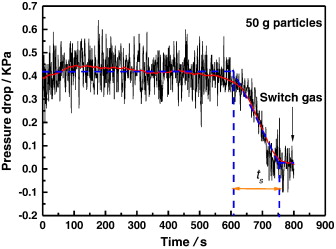The sticking behavior was a key point for the industrialized development of the fluidized bed in iron-making which has been extensively investigated by many researchers. But hardly any appropriate parameter was found to describe the process and the sticking behavior from the occurrence of sticking to defluidization and the influence of fluidization conditions on it were scarcely investigated.
Researchers with Institute of Process Engineering (IPE) achieved progress on this subject. To simplify the chemical composition of iron ores, they selected chemical grade Fe2O3 particles as the model material for reduction in the fluidized bed. The pressure drop was examined during reduction of Fe2O3 particles with CO. Based on the pressure drop, the sticking time was introduced to describe the sticking characteristic. Besides, the effects of fluidization conditions on the sticking time were compared.
In their work, the first step was to prepare Fe2O3 particles in the fluidized bed reactor under specific conditions. After obtaining the particles, they were examined with scanning electron microscope (SEM) to study their surface structure, and the internal structure was examined with an optical light microscope (LM).
The sticking during the reduction in the fluidized bed was determined by the abrupt change of pressure drop through bed. The figure shows the variation of the pressure drop with the reduction time in CO–N2 gas mixture (CO2 L/min, N2 1 L/min) at 973 K. As showed the time between the two intersections of three tangent lines i the sticking time.
Based on the experimental data, researchers made a comparative study of the influence of fluidized conditions. The order was temperature > CO concentration > reduction potential > gas velocity. How these aspects effected the sticking time was studied. Results indicated that the sticking time decreased with increasing CO concentration and reduction potential as a consequence of increasing iron–iron contact area when particles collided. While the sticking time increased with gas velocity, resulting from increasing momentum of particles. Due to the increase of the surface energy of precipitated iron, as a dominant source of driving force for sticking, the sticking time decreased as the temperature increased.
This work is supported by National Natural Science Foundation of China and Baosteel. The paper was published in Power Technology.

Variation of the pressure drop with reduction time (image by IPE)